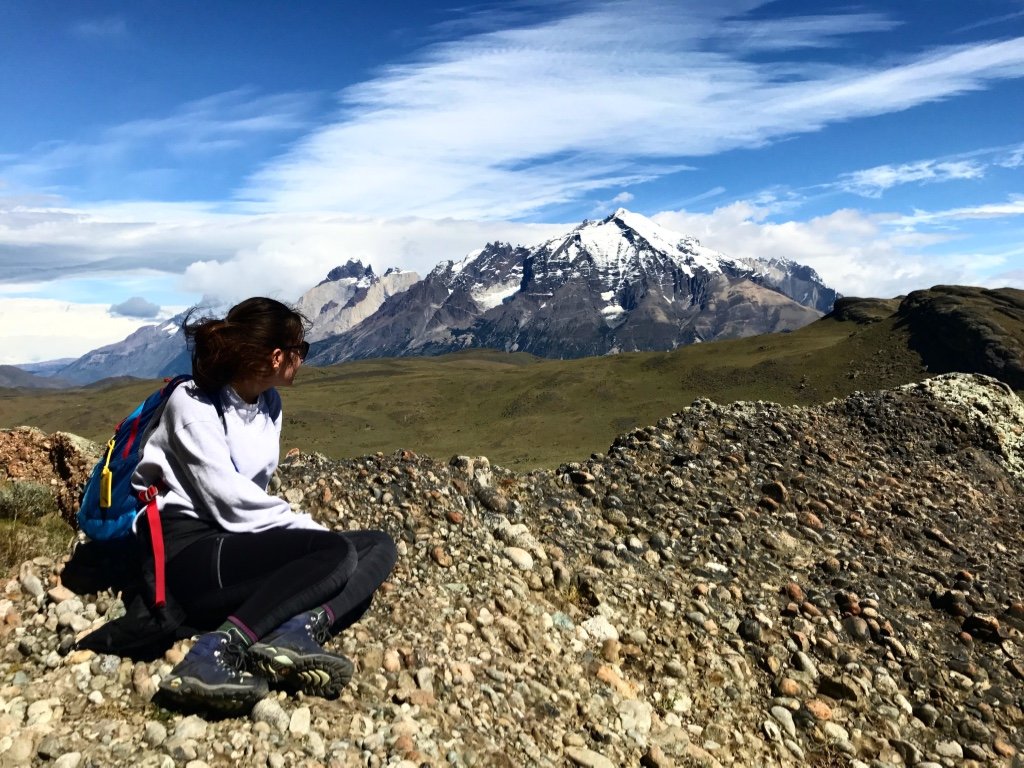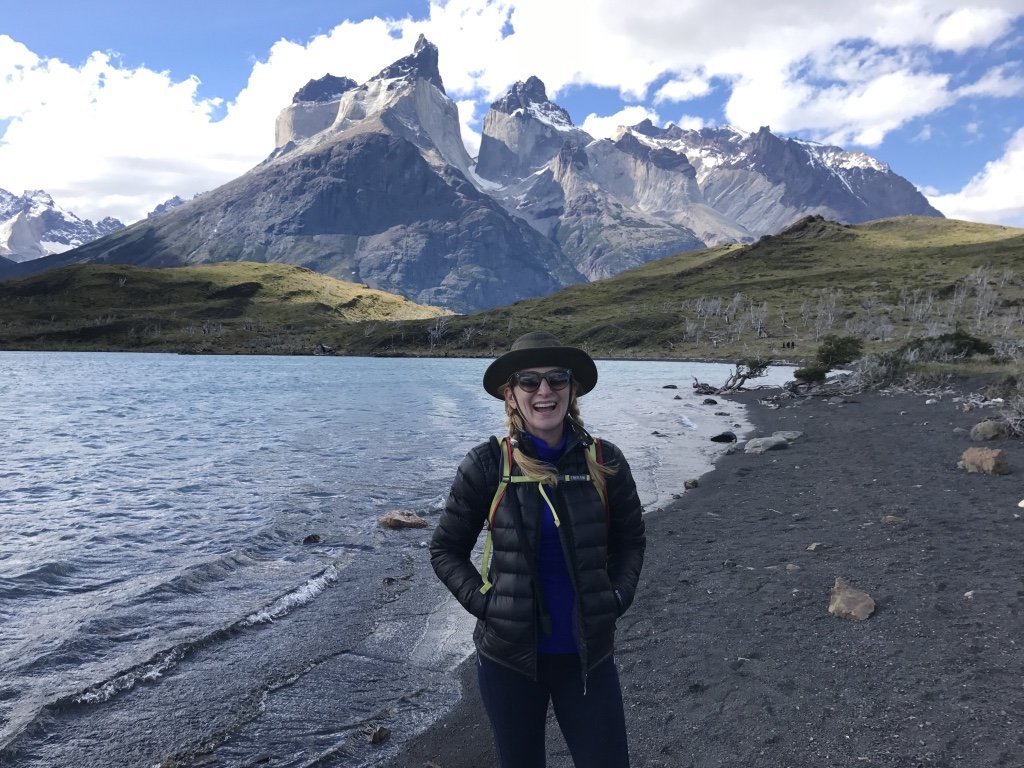Patagonia: Gauchos, Grit, and Glorious Scenery
Getting to Patagonia is an adventure on to itself. The journey begins with a nine-hour flight from Los Angeles to Santiago, Chile, followed by a four-hour flight from Santiago to Punta Arenas (commuter jet, feared for our lives), and now, Roxy and I are told that we have a four-hour van ride ahead of us on the “Ruta de Fin del Mundo” (route to the end of the world). Roxy sums up the arduous journey by asking, “What do you think we’ll experience first? The end of the world or check-in?”
We eat a lovely picnic lunch in the van packed by our lodge, and make a brief stop for espresso in Punta Arenas, which serves as the gateway to Antarctica, and Patagonia. As the landscape gradually changes from desolate desert to lush and pastoral, the iconic ice-capped Torres del Paine come into view. Seeing the three granite towers makes our hearts leap. We sense that the seemingly endless transfer will be worth it.
As we pull up to Tierra Patagonia, an architectural masterpiece, the lodge appears like a space station on some distant planet. Immersed in the wild landscape and emerging from the hillside, the sprawling structure is all glass and wood. Designed specifically to showcase the jaw-dropping vistas of the Torres del Paine National Park, the lodge inhabits an area that was declared a UNESCO Biosphere Reserve in 1978. Despite our exhaustion, we are awe-struck and excited to explore everything the lodge and park have to offer.
The manager personally welcomes us. He tells us that the lodge is eco-friendly, and its natural beauty is sustainable. “We are very proud of this,” he says. Together, we walk inside the lobby, which serves as both a living room and dining room for the guests, we are struck by the casual and cool furnishings, dramatic, curved wood ceiling, large circular enclosed fireplace, and expansive windows that open to the world’s most stunning mountain range. Splendidly positioned for exploring the Patagonian outdoors, we are thrilled to be staying at this cozy, casual hideaway.
The guests are smart and well-traveled, and I’m loving the conversations. What’s clear is that Patagonia attracts a certain kind of adventurer--someone who has been around the world and is seeking new frontiers—places that are wild and unsettled.
“It seems you’ve traveled to so many exciting places. What’s your absolute favorite in the world?” I ask one of the guests. “Hands down, India. It’s like nowhere else.” We listen to their travel stories and share some of our own adventures that span from Morocco to Japan. Connections are made easily. There’s a like-mindedness, a global consciousness, but most importantly, we find ease with our fellow guests, who are open and friendly.
In the morning, we meet our first guide who is affectionately called Pato (“duck” in Spanish). He takes Roxy and me to the lakes, through the forest and down a steep, sandy trail. The five-hour hike is magical with eye-popping views at every turn. Over a delicious picnic lunch, Pato says to us, “When you go home, everything will be the same. The only thing changed will be you.” This is the articulation--the very essence of why Roxy and I travel, to find out who we are at our core, to change, to stretch ourselves, and grow.
I believe that when you are taken out of your comfort zone and put inside a situation that’s completely foreign, you will discover your true character. I know so many people who pat themselves on the back for never taking vacation time. They wear their commitment to their company like a badge of honor. I think it’s hogwash. My best ideas have come to me while soaking in hot springs in Big Sur, poking through an outdoor flea market in Paris, taking a cooking class in Oaxaca and looking out at the sea on the Costa Brava.
Success and self-confidence don’t come from staying inside and looking at a screen, it comes from getting out and challenging yourself. I find that the more extreme and unexpected the adventure, the higher the rewards. I can say to myself, “If I can do all of these things when I travel, when I get back home, I can win more business, ask for more money, write another book, make a difference in the world and do it all while raising Roxy. What travel gives me is the feeling of no limits.
Back at the lodge, we join a family from Chicago for dinner. We are thrilled with the modern Patagonian cuisine. Even at the end of the world, we are served beautiful seafood, lamb from nearby estancias (ranches), slow-cooked soups and hearty stews. After hours of conversation, many generous pours of good Chilean Pinot Noir, I’m ready to turn in. I say goodnight and leave Roxy with her new friends who are breaking out the Scrabble game board. I sleep as hard as a pyramid. It’s been a long time since I just let go, and it feels so good to get eight solid hours of rest.
We awake in our room to a dead-on view of the Torres del Paine, the three granite peaks of the Paine Mountain range. They rise up to 8,200 feet above sea level. I have an I can’t believe we’re here feeling that surfaces in me like the sun coming up on this gorgeous day. I shower, pull on my hiking pants, base layers, black puffer jacket, and trail runners. I leave my hat in the room. Yesterday, it blew right off my head and rolled on its side until our agile Pato caught it. I’m not taking any chances today. The wind whips this time of year and can reach top speeds of 74 miles per hour. I’ll just have to slather on the sunscreen.
After a hearty breakfast, Roxy and I travel to one of the many estancias in Patagonia. Every year, Baqueanos— Chilean cowboys—ride over thousands of miles on horseback to round-up sheep for shearing and to harvest their high-quality wool.
Inside the large barn, Roxy and I find hundreds of sheep quietly and tightly standing together. It smells like wet wool and wood. The adorable sheep have tiny heads, spindly legs and black hooves, their middles chunky with think wool the color of cream. Suddenly, with powerful force, each Baqueano secures a sheep by the hooves, and in one flick of the wrist, flips it over belly up, and wedges it between their legs. With oiled shears, piles of wool are carved off each sheep. One-two-three: The sheep are naked of their coats. They trot in a daze down the wooden ramp and back into the pasture.
Under Patagonia’s never-ending sky, we ride on stately white horses with a gaucho who looks like Captain Morgan. His epic mustache, long thick mane of black hair, red cape, tall black boots, and beret are macho and magnificent. “Do you think he wears that every day or just for tourists?” I ask Roxy. “Are you kidding? He lives in that outfit,” Roxy says. We follow his lead, riding without a path, blazing our own trail to a hilltop overlooking the ranch, the channels, and the mountains. Looking straight out of central casting on top of his horse, Captain Morgan smokes a rolled cigarette and gallops effortlessly against the wind over the wild terrain. He seems to be having a significant effect on our riding mates, Sarah, and Susan. We are all transfixed.
After an incredibly beautiful and bouncy horseback ride, we have a long lunch back at the hotel with old wine and new friends. Sarah and Susan join us along with the Chicago family, and we tell them about Captain Morgan and the sheep shearing.
In a wine haze, we soak in the pool, get massages and nap, all with the Torres in the foreground.
On our third day, we head out for a morning hike. Roxy and I are joined by a family from Atlanta whom we met last night at dinner. Pato leads us to the top of the masa and along the trail where we discover animal bones and condors soaring in the robin’s egg-blue sky. Ten condors in all swoop and circle, a rare sight to behold, according to our grinning guide. The famous bell-shaped mountains, Torres del Paine, rise up ahead as we navigate the labyrinth of round, spiky bushes called “mother-in-law.”
The entire landscape looks sculpted and hyper real. Patagonia is virtually untouched, most probably because you have to hike to really see it. It’s clear and clean and heart-stoppingly gorgeous. And, as I mentioned before, it’s also plenty windy. Today, we’ve got a gale, the wild clouds roar by. We’ve been told that’s because Patagonia is so much farther south than any other land mass—except for Antarctica.
After another few days of equally exciting excursions, it’s time to go, and my heart is heavy. I’ll miss hanging out at the lodge, which feels more like a club house than a hotel, eating grilled meat, fish and satisfying stews, and toasting glasses of delicious Chilean wine, indulging in a spa treatment here and there and talking for hours upon hours with fellow travelers. We didn’t just hike for miles each day; we had a complete experience in Patagonia.






